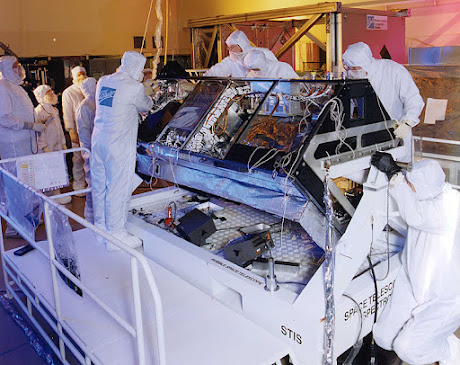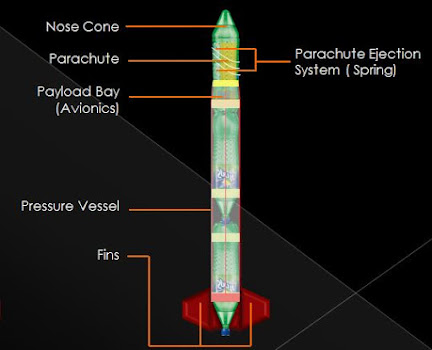HOW HUBBLE TELESCOPE CAPTURES LIGHT, ANALYSE IT AND SEND IT TO US??
Let's start with "how Hubble captures light?"
For capturing light we need an optical system. Hubble space telescope(HST) uses a mirror-based optical system called optical telescope assembly(OTA), first, the light from the astronomical object enters into HST and strikes on the big “Primary mirror(PM)” which is a concave mirror, and the light gets reflected from PM and starts to converge and strikes on a small “Secondary mirror(SM)” which is a convex mirror and placed in front of the PM, the light hits the SM in a such an angle that after reflection all the light concentrates into a beam and that travels through a hole in the PM and received by the scientific instruments.It works like a Cassegrain telescope(normal reflecting telescope), in a standard Cassegrain telescope there will be parabolic mirrors but in HST mirrors are hyperbolic so they can form a sharper image over a wider field of view and this version is known as Ritchey-Chrétien design.
The OTA is supported by a graphite-epoxy skeleton. It was chosen for the frame of the OTA because it is lightweight, stiff, and strong. The primary mirror is big and it is designed in such a way to have less mass, so NASA made a honeycomb structure instead of a solid core for the primary mirror and this reduces the mass from 3,636 kg to 818 kg.
Then how does it analyze the received light?
Now let's see about the instruments, there are three main types of instruments in HST for analyzing the received light. The first one is nothing but cameras! There are two types of cameras in HST, that are Advanced Camera for Surveys (ACS) and Wide Field Camera 3 (WFC3).WFC3
ACS
ACS is for wild field imagery especially for visible light but still, it can also be used for UV and near-infrared light. WFC3 provides wide-field imagery especially for infrared and ultraviolet wavelengths, WFC3 is a complement for ACS and expands its ability to see the cosmos.
COS
STIS
The second instrument is spectrographs(the device which splits up the light into different frequencies and it is helpful to study the object’s characteristics such as temperature, density, chemical composition, and velocity), HST has two Spectrographs, one is Cosmic Origins Spectrograph (COS) which is used to measures exceedingly faint levels of ultraviolet light emanating from distant cosmic sources and the other is Space Telescope Imaging Spectrograph (STIS) which is especially used to study bright objects.
The third instrument is known as interferometers, HST uses three interferometers which are also called fine guidance sensors(FGS), two of FGS used for gathering data for pointing control system of HST, which measures the relative position of HST accurately with respect to a guide star and third FGS used for the scientific purposes such as celestial object’s angular diameter or star positions.
Ok, then what about communication?
Let me start from the process of determining the position of Hubble’s next shot of the cosmos, first, the location in which Hubble going to focus next will be confirmed by the Space Telescope Science Institute(STSI) in Baltimore, Maryland and then they will send the essential data about that target to Space Telescope Operations Control Center (STOCC) at NASA’s Goddard Space Flight Center in Greenbelt, Maryland and this is the place from where the HST is operated and maintained.Now STOCC will communicate with HST with the help of NASA's Tracking and Data Relay Satellites (TDRS) which are in the geosynchronous orbit. Okay now first STOCC will send the commands to TDRS through dedicated radio dishes at the White Sands Complex and that commands will be received by HST from the TDRS. All these communications will happen in S-band which has a range from 2 to 4 GHz.
TDRS has two types of antennas to receive and transmit data, first, one single-access antenna(SAA), and another is the multiple-access antenna(MAA). As the name suggests in a single access antenna only data from a single user can be received or transmitted at a single moment whereas in a multiple-access antenna multiple data can be received or transmitted from multiple users at a single moment. These two types of antennas provide different signal transmission speeds or data rates. The data rate for SAA is higher than that of MAA. All the commands from the control station are received and that commands are transmitted to HST through either MAA or SAA.
Now let's see how images and scientific data are transmitted by HST to the ground station. These images and scientific data are large so HST uses its HGA to transmit these data to TDRS. TDRS receives these data and transmits it to STOCC with the help of its SAA which has a higher data rate. The STOCC will give these data to STSI. And this is the end of the communication odyssey but this is the start of the exploration odyssey.













Comments
Post a Comment